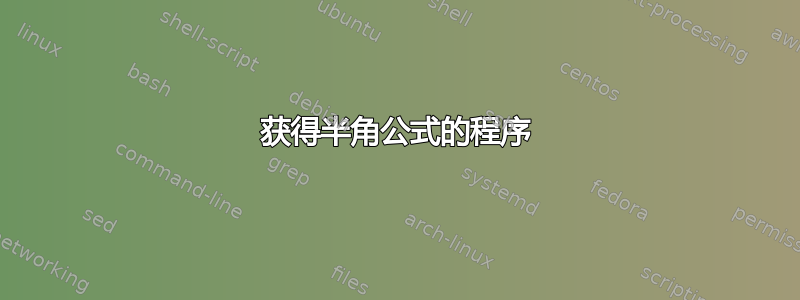
我正在尝试编写获取半角公式的程序,但什么也没写出来。我不知道这样做是否太复杂了。
我当前的代码是:
\documentclass{article}
\usepackage{amsmath}
\begin{document}
\begin{align*}
\cos^2 \left( \dfrac{\alpha}{2}\right) - \sin^2 \left( \dfrac{\alpha}{2}\right) &=\cos \alpha \\
\cos^2 \left( \dfrac{\alpha}{2}\right) +\sin^2 \left( \dfrac{\alpha}{2}\right) &=1\\
\\
2\cos^2 \left( \dfrac{\alpha}{2}\right) &= 1+\cos \alpha \Rightarrow \cos^2 \left( \dfrac{\alpha}{2}\right) =\dfrac{1+\cos \alpha}{2}\Rightarrow \cos \left( \dfrac{\alpha}{2}\right) = \pm \sqrt{\dfrac{1+\cos \alpha}{2}}
\end{align*}
\end{document}
答案1
您可以使用alignat,它类似于,align但列之间没有间距。(此外,您必须指定有多少个列对。)然后,您可以为水平线添加一个rule内部。\rlap
列交替左右对齐,因此要获得连续的左对齐列,请使用&&。在您的表达式中,\cos是左对齐的,然后=又是左对齐的。
\documentclass{article}
\usepackage{amsmath}
\begin{document}
\begin{alignat*}{2}
&\cos^2 \left( \dfrac{\alpha}{2}\right) - \sin^2 \left( \dfrac{\alpha}{2}\right)&&=\cos \alpha \\
&\cos^2 \left( \dfrac{\alpha}{2}\right) +\sin^2 \left( \dfrac{\alpha}{2}\right)&&=1\\[-1ex]
&\rlap{\rule{5.1cm}{.5pt}}\\[-1ex]
2&\cos^2 \left( \dfrac{\alpha}{2}\right)&&= 1+\cos \alpha \Rightarrow \cos^2 \left( \dfrac{\alpha}{2}\right) =\dfrac{1+\cos \alpha}{2}\Rightarrow \cos \left( \dfrac{\alpha}{2}\right) = \pm \sqrt{\dfrac{1+\cos \alpha}{2}}
\end{alignat*}
\end{document}
答案2
您可以使用array。
\documentclass{article}
\usepackage{amsmath}
\usepackage{array,booktabs}
\begin{document}
\[
\setlength{\arraycolsep}{0pt}
\newcommand{\halpha}{\left(\frac{\alpha}{2}\right)}
\begin{array}{
>{\displaystyle}l
>{\displaystyle{}}l
>{\displaystyle{}}l
}
\cos^2 \halpha - \sin^2 \halpha &= \cos \alpha \\
\addlinespace
\cos^2 \halpha + \sin^2 \halpha &= 1 \\
\addlinespace
\cmidrule{1-2}
2\cos^2 \halpha &= 1+\cos \alpha
& \implies \cos^2 \halpha = \frac{1+\cos \alpha}{2} \\
\addlinespace
&& \implies \left|\cos \halpha\right| = \sqrt{\dfrac{1+\cos \alpha}{2}}
\end{array}
\]
\end{document}
定义本地命令\halpha对于保持代码尽可能紧凑很有用。但是如果你将定义修改为
\newcommand{\halpha}{\frac{\alpha}{2}}
你会减少分心(在我看来)
数学注释。我发现在这种情况下使用 ± 会产生误导:学生在学会在二次方程中使用 ± 后才发现这一点,因为在二次方程中它具有非常不一样意义。
答案3
这是一个完全不同的布局,值得考虑。它避免了在第 3 行中出现向右漫无目的地游荡的长“尾巴”。此外,它使用\tfrac而不是\dfrac。
\documentclass{article}
\usepackage{mathtools} % for \mathrlap macro
\usepackage{booktabs} % for \midrule macro
\newcommand\alphahalf{\bigl( \tfrac{\alpha}{2} \bigr)}
\begin{document}
\[
\begin{aligned}
\cos^2 \alphahalf - \sin^2 \alphahalf &=\cos \alpha \\
\cos^2 \alphahalf + \sin^2 \alphahalf &=1 \\
\midrule
2\cos^2 \alphahalf &= 1+\cos \alpha \\[2\jot]
\Rightarrow \cos^2 \alphahalf &= \mathrlap{(1+\cos \alpha)/2} \\
\Rightarrow \cos \alphahalf &= \mathrlap{\pm \sqrt{(1+\cos \alpha)/2}}
\end{aligned}
\]
\end{document}







